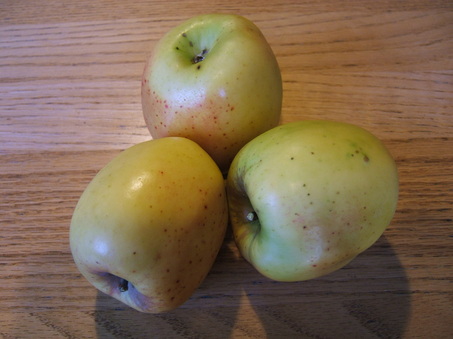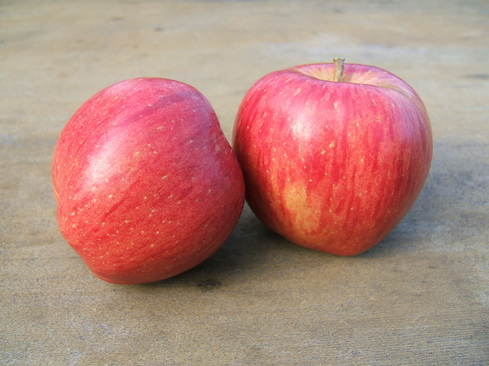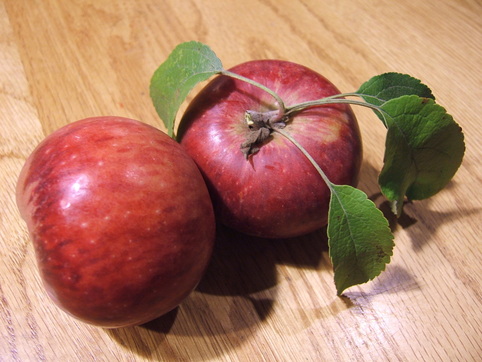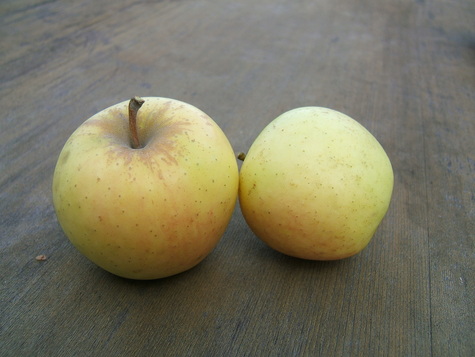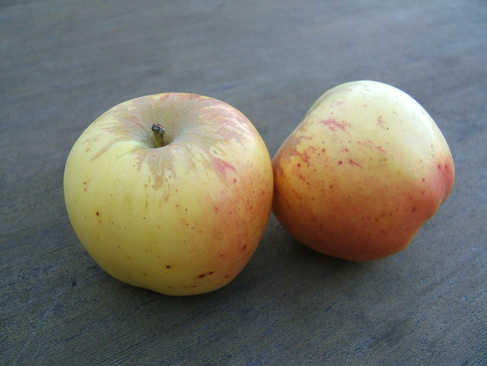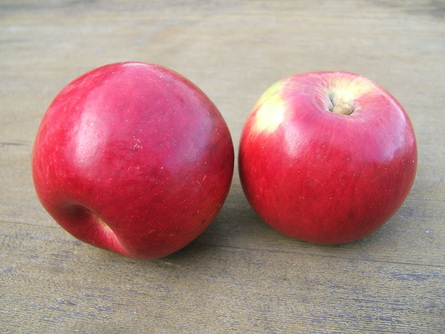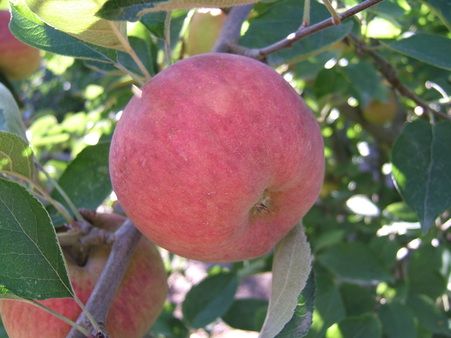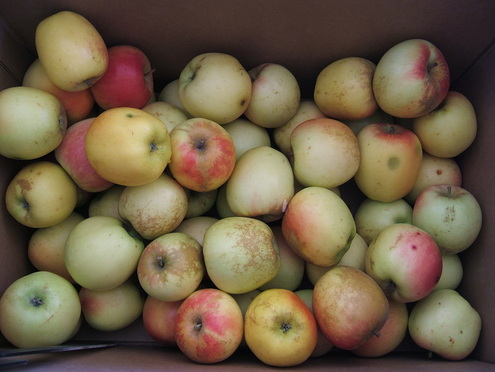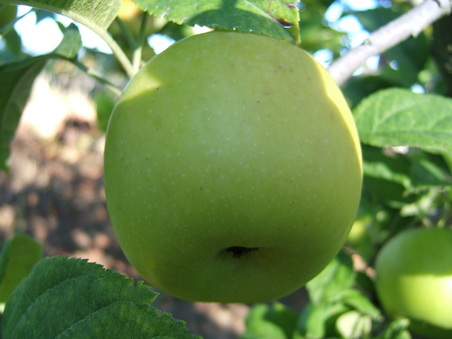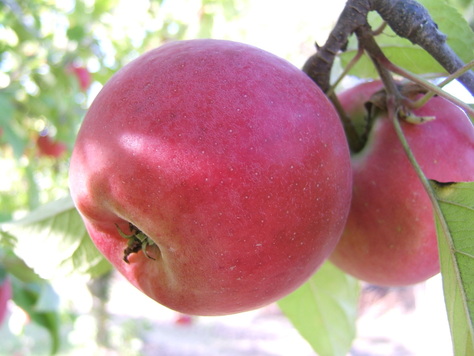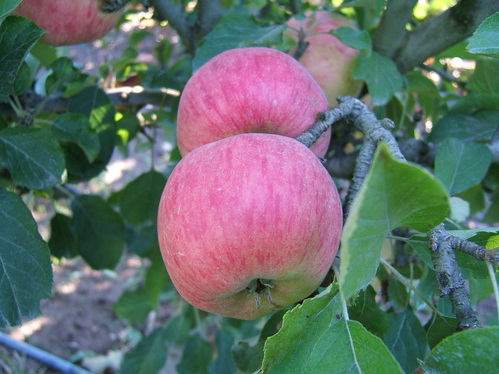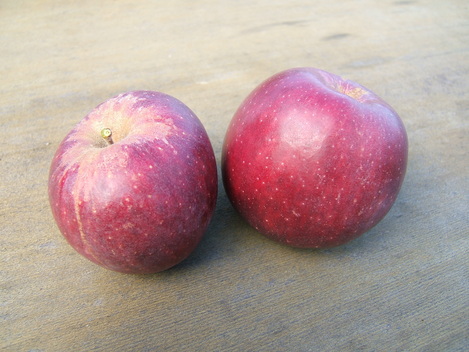Apples, apples, apples! We told you, we really love apples. Take a look below at all the varieties we are currently growing.
Akane
Season: Late October/mid November
Origin: Introduced in 1937 in Japan. A cross between a Jonathan and Worcester Pearmain.
Tasting Experience: Medium to large fruit, with a red blush. When ripened properly, it is almost completely red in Sebastopol. Creamy texture, white flesh, with sweet aromatic flavor. Holds shape when baking and therefore is a very good snack and/or dessert apple.
Amere de Berthcourt
Season: September/October
Origin: France, date unknown
Tasting Experience: The Amere de Berthcourt is an incredible cider apple. It is a bittersweet, meaning it has low levels of acidity and is high in tannin. The apple is yellow/green with a red blush. The flesh is sweet and lightly bitter. We don't recommend eating this apple - will make you pucker!
Apricot
Season: October/November
Origin: The apple was discovered near Salem, Oregon by Oregon apple enthusiast Lon Rombough in the 1980’s.
Tasting Experience: Aptly named, the apple has been described to have an apricot aftertaste. The flesh is yellow and fruit hangs on to the tree into the late fall. The apple is described to be good to eat out of hand.
Growing Notes: In 2013 we planted 13 Apricot trees and are excited to bring them to market.
Arkansas Black
Season: Late October/mid November
Origin: This variety was found in Benton County, Arkansas in the mid 1800's and is believed to have come from a Winesap seedling.
Tasting Experience: With deep red, almost black skin the Arkansas Black is one of the darkest skinned of all varieties. The taste is sweet, tart and wine-like. The flesh is yellow, hard and crunchy. The apple stores very well and gets sweeter with time. This variety is very good for baking (although does not hold shape) as well as cider making. Be sure to check in with us to see when the Arkansas Black are here; they are a crowd favorite and go fast!
Ashmead's K
Season: Late August/early September
Origin: England, early 1700's. Parentage unknown.
Tasting Experience: This old English variety has remained popular for over two centuries thanks to its distinctive pear flavor. It thrived here in North America after being introduced from Europe and does particularly well in our coastal climate. Its standout features are a red-orange blush and brown russet. The Ashmead's Kernel is quite versatile and can be used for baking, salads, juice and cider.
(Yellow) Bellflower
Season: November
Origin: New Jersey, USA, 1742. Aptly named for its large white/yellow blossoms.
Tasting Experience: This large winter apple is always a favorite for making pies. It is very, very dense and firm, with citrus and grapefruit-like flavors. In Sebastopol, it is one of the last apples to be harvested. We have only five trees so we don't store the apples, but they do keep well.
Belle de Boskoop
Season: Late October/early November
Origin: Boskoop, Netherlands. 1850's
Tasting Experience: A large, red apple with a russet. The apple is suitable for both dessert and culinary uses. The flavor is sharp with a white/green flesh that is dense and firm.
Best Ever
Season: Late September/early October
Origin: Chance seedling from the Davisson Orchard, Sebastopol, CA
Tasting Experience: This juicy, crisp and sweet apple may look a lot like a Red Delicious but is very, very firm and has a little more spice. The skin is colored beautifully and has tannins which add complexity to the taste. A great snacking apple and can be used to bake as well.
Blacktwig
Season: Late October/early November
Origin: Discovered in Tennessee around 1830 as a seedling and some sources say it was introduced into Arkansas in 1868.
Tasting Experience: This variety became a popular dessert apple in the 19th and early 20th centuries and is rumored to have been President Andrew Jackson's favorite apple. It has a very firm and crisp flesh that is both sweet and tart, yet has a tannic finish. The flavor is robust and has spice undertones. Cider makers love them! The variety keeps well and is great for eating and baking.
Growing Notes: It tends to bear every other year and it is susceptible to worms, since it is a very late apple, one of the last to be harvested in Sonoma County.
Braeburn
Season: Mid October
Origin: New Zealand, introduced in 1952 by a chance seedling.
Tasting Experience: The fruit of this variety range from medium to large in size and have a green-yellow background with an orange-red blush. Tart and firm, it's great for both eating fresh and baking.
Growing Notes: Because we only have a few young trees of this variety we don't have a big crop. It is very sensitive to common apple diseases but the fruit stores quite well, which has made many commercial growers adopt it.
Bramley's Seedling
Season: Late September/early October
Origin: Nottinghamshire, England. The first tree was planted around 1809. Matthew Bramley bought the orchard in 1846 and sold cuttings of the to a nurseryman, Henry Merryweather and thus began its widespread cultivation. The variety received many awards, and was extensively planted well in the early 1900's. The original tree, despite storm damage in 1900, is still bearing fruit.
Tasting Experience: If you like a really tart, acidic, and crisp apple, then this variety is for you! The English consider it one of the best apples for baking: apple pies, crisps, etc. We have one mature tree and have planted a few young trees.
Brushy Mountain Limbertwig:
Season: November
Origin: The apple originated in the Brushy Mountain Region of northwest North Carolina. The ‘Limbertwig’ apple trees are most well known and identified by their drooping apple tree branches.
Tasting Experience: The apple is a great eating apple: a mix of sweet-tart with a complex flavor. Best used sliced as the texture is very dense. The apple has a yellow skin with red blush and some russet.
Bulmer's Norman
Season: September/October
Origin: Normandy France, late 1800’s. The apple was imported into Hereford, England and made famous by HP Bulmer & Co. The rootstalk is typically used for grafting due to the strength and vigor of the tree.
Tasting Experience: Typically used in ciders, the Bulmer’s Norman is a bittersweet (low acid, high tannins) apple variety. The apple is medium to large in size and has a yellow/green skin. Due to its high tannin content, we don't recommend eating this apple - best to use it for juicing/cider making.
Burgundy
Season: Mid August
Origin: Developed in New York at Cornell University. Cross between a Monroe and (Macoun x Antonovka). The apple was developed between 1953 and 1974.
Taste Experience: The fruit is large and round with a dark red color. The flesh is crisp, tart, spicy and has an underlying flavor of honey. The fruit develops its dark pigment long before it ripens, which makes it susceptible to sunburn due to heat absorption. In late harvest, the fruit will have become almost completely burgundy-colored. Some Burgundy's, when sliced have the skin color bleed into the flesh, showing a bit of a pink hue.
Cap of Liberty
Season: September
Origin: England/France 1200’s.
Tasting Experience: A very old vintage bittersharp (high acid and tannins). Best used in cider, not for eating.
Growing Notes: In 2013 we planted three Cap of Liberty trees and will use them primarily for cider making.
Chisel Jersey
Season: October
Origin: Believed to have originated in the 19th century in Martock, central Somerset, England.
Tasting Experience: A bittersweet (low acid, high tannins) apple. The fruit is round with a red background and a pink/brown blush. In old English, ‘chisel’ means ‘pebble’. This name was given to the apple due to its small and russeted appearance.
Growing Notes: In 2013 we planted two Chisel Jersey trees and plan to use them for cider making.
Cinnamon Spice
Season: September
Origin: Unknown, found near Bolinas, CA.
Tasting Experience: This variety bears small to medium sized, red fruit with a golden blush. It is very sweet and tastes distinctly of cinnamon when perfectly ripe. The apple has a very crisp texture.
Cox's Orange Pippin
Season: October/November
Origin: England, 19th century, discovered as a chance seedling.
Tasting Experience: Best eaten fresh, this apple has an extraordinary flavor. The complexity of the flavor makes it one of the best eating apples. This apple shines when compared to others. It is also great to use in cooking, baking and juicing. Texture is hard and crisp.
Criterion
Season: October
Origin: Chance seedling from Parker, Washington, 1960's
Tasting Experience: A wonderful all-purpose apple whose parentage includes Red Delicious, Golden Delicious, and Winter Banana. It is a large fruit and has a mild, sweet taste with just a touch of tartness. The variety has a very pleasant aroma and is recommended for cooking, baking, cider, juicing, eating and drying.
Crimson Gold
Season: October/November
Origin: Developed by Albert Etter in 1944 who originally named it Little Rosybloom. Albert Etter died before the patent work was completed and when it was later discovered, it was renamed Crimson Gold. Experts disagree if the apple is a cross between a Yellow Newton Pippin and Esopus Spitzenburg or a crabapple hybrid. We will never know!
Tasting Experience: The apple has a yellow background covered by a ruby red foreground. The flesh is crisp with a sweet/tart flavor. Extraordinary eating, juicing and baking. The apple retains its shape even at high cooking temperatures.
Davisson
Season: Mid October/late November
Origin: Non-patented variety, discovered as a chance seedling in the Davisson Orchard in Sebastopol, CA.
Tasting Experience: This small but beautiful apple has red stripes over a yellow background. Similar to a Gala, the Davisson has a firm, dense, and crisp texture with a sweet taste. Great dessert apple and pairs well with Almond butter.
Doux Normandie
Season: September
Origin: Originated in Normandy France, 1800’s
Tasting Experieince: The Doux Normandie is a bittersweet (low acid, high tannins). A green apple with a orange blush, the Doux Normandie produces a perfumed and aromatic juice and is therefore great for cider production.
Growing Notes: In 2013 we planted three Doux Normandie trees and will use them primarily for cider.
Egermont Russet
Season: October/November
Origin: Discovered in Sussex, England and introduced to the market in 1872.
Tasting Experieince: This is the quintessential English russet apple. The apple is small and yellow but covered with a russet. Sometimes the apple has a faint pink blush. The flavor is rich and nutty and the texture is dry and firm. An excellent variety to pair with cheese.
Growing Notes: In 2013 we planted 13 trees and are excited to bring them to the market for the true apple lovers who aren't scared of a an apple that's a little rough around the edges.
Empire
Season: Early September
Origin: Cornell University, NY, 1940's. The name Empire was a homage to the state in which it was cultivated.
Tasting Experience: It is a very sweet apple with a good amount of acid to balance the flavor. There is a spice reminiscent of the McIntosh found in Empires. One of the top 10 American varieties, this cross between McIntosh and Red Delicious is mostly grown in the North-East USA.
Growing Notes: It is a reliable variety that has good crops and is somewhat easy to grow. Crispy and firm, the Empire does not bruise easily and was readily adopted by retailers and distributors.
Empress
Season: September
Origin: Developed by New York Fruit Testing in 1966, the Empress is a cross between a Jonamac and a Vista Bella.
Tasting Experieince: A plum shaped apple with a deep purple blush. The flavor is sweet with a bit of acidity and notes of anise. The Empress is often compared to the Empire, however it is harvested a month earlier.
Esopus Spitzenburg
Season: Late September
Origin: Was found in NY state in the late 1700's. Said to be Thomas Jefferson's favorite apple. The apple is named after the county in which is was discovered.
Tasting Experience: One of the best eating apples, it has slightly dry flesh with an incredible sweet-tart flavor. The Spitzenburg is a great apple for hard cider because of its acidity and makes excellent apple galettes because it holds its shape.
Growing Notes: The variety is difficult to grow in Sonoma County because it is extremely vulnerable to apple scab, fire blight and worms. The trees tend to bear every other year.
Fameuse
Season: late September/early October
Origin: French plantings in Québec, Early 1800's. Probably an ancestor of the McIntosh.
Tasting Experience: The fruit is quite small and has the same crimson skin color and white sweet flesh as the McIntosh. Very aromatic: vinous/sweet flavor. Quite late to ripen, very firm and good for eating fresh, juicing or baking. The variety is resistant to some diseases, but very sensitive to scab.
Fowhelp
Season: September/October
Origin: The Foxwhelp is a very old apple originating as early as the 1660’s in either Herefordshire or Gloucestershire county in England. Once highly esteemed as one of the best cider-producing varieties, it was often compared to French wines.
Tasting Experieince: Classified as a bittersharp apple, meaning it contains high levels of tannins and malic acid. The juice from the Foxwhelp has a very high sugar content, and thus when fermented produces a high-alcohol cider.
Frequin Rouge
Season: October/November
Origin: The Frequin Rouge originates in the westernmost region of France, Bretagne.
Tasting Experieince: The Frequin Rouge is a bittersweet apple (low acid, high tannins). The juice from the Frequin Rouge makes for a wonderful cider. The apple is globular to flat/round in shape and has a yellow background with red stripes. The flesh is crisp and juicy, however we do not recommend eating the apple as it is very high in tannins.
Fuji
Season: mid October/mid December
Origin: developed in Japan in the 1930's, but it is a cross between two American varieties, Red Delicious and Ralls Janet.
Tasting Experience: There are many natural variations. Our variation and climate give pink-red stripes and blush over a yellow-orange background. The flesh is white, crisp, juicy and cuts cleanly. Kids really love them! The Fuji needs a lot of sunshine. It is very widely grown and represents 70% of China's apple trees. Late harvest Fujis tend to water-core, which means that the flesh gets translucent streaks and becomes extremely juicy. This is the last variety that we harvest during the year. In mid November we will strip the trees completely and put the remaining Fujis in cold storage to sell into the new year.
Golden Delicious
Season: October
Origin: West Virginia, late 19th century
Tasting Experience: This apple is sweet, fresh and juicy. It has a green-yellow color and white flesh. The greenest Golden Delicious will have a nice acidity but the riper ones will be sweeter and reminiscent of honey. This variety is easy to grow and keeps well during storage which has made it a supermarket staple. But unlike the apples you find in supermarkets, ours are harvested at the peak of ripeness and taste much better.
GoldRush
Season: Late October
Origin: The original seedling of the GoldRush was planted in 1973 in Indiana. The cultivar was developed by the cooperative breeding program of the Indiana, Illinois and New Jersey Agricultural Experiment stations. The GoldRush is a Golden Delicious cross.
Tasting Experience: The Gold Rush is a delicious tangy apple that will sweeten with age. Great in pies and crisps! Deep yellow apple that is smooth and nonwaxy.
Growing Notes: Resistant to scab and mildew!
Golden Russet
Season: September
Origin: The origins of the Golden Russet are unknown, but it is believed to be a seedling of an English Russet variety. It originated in New York state and was introduced in 1845.
Tasting Experience: The Golden Russet is said to be one of the best tasting American russet cultivars. It has good flavor for eating and also cooks and juices well. The apple has fallen back into favor due to the revival of the cider industry. The flavor is intense, both sweet and tart. The texture of the skin, which is fully russeted, may deter some folks from trying the apple, but we think it’s worth it!
Growing Notes: Back in 2013 we planted 19 Golden Russet trees.
Golden Supreme
Season: Early September
Origin: Clay County, West Virginia. Chance seedling of Golden Delicious from open pollination.
Tasting Experience: This variety has softer skin and is more flavorful than the standard Golden Delicious. When harvested at peak ripeness the apple is very juicy, crisp and sweet with pear and honey-like flavor. It is susceptible to apple scab in our climate. Both the Golden Supreme and Delicious store really well, and if picked ripe and subsequently stored, they hold for quite some time.
Granny Smith
Season: Late October
Origin: Australia, discovered in the 1860's by Maria Ann Smith, most likely a seedling from French Crab. Introduced in the US by Grady Auvil in 1972.
Tasting Experience: This grass-green apple is crisp, tart, juicy and excellent for eating and baking. When baking, the Granny Smith holds its shape. Additionally, the Granny Smith is also great in salads, because it doesn't turn brown once cut due to the antioxidants that also make them tart!
Growing Notes: This variety is quite resistant to scab, but can have a few more worms because it's a late apple.
Gravenstein
Season: Early August
Origin: Discovered in 1669 in South Denmark, although it may have come from Italy first. First brought to the US in the early 19th century, probably by Russian fur traders into Fort Ross, California. The Gravenstein was declared "National Apple" of Denmark in 2005. The apple industry soared around Sebastopol, given the suitability of the Gravenstein for processing. During WWII, american troops were even supplied with dried and canned apples from Sebastopol. Today, the number of acres in Sebastopol that are planted with apples particularly Gravensteins, has decreased dramatically. The Slow Food USA movement is trying to help the variety keep its place in Russian River Valley's local agriculture.
Tasting Experience: A ripe Gravenstein is orange with dark stripes. The fruit is tart, very flavorful, and perfect for cooking: sauce, pies, cider, etc... We have three strains/sports of Gravenstein: standard Gravenstein, Red Gravenstein and Rosebrook.
Grenadine
Season: Mid-late October
Origin: Another apple cultivated by Albert Etter.
Tasting Experience: The Grenadine is one of the latest of the Rosetta apples to bear fruit. The Grenadine has a pink rosy flesh that bleeds into the skin of the apple creating an almost purple skin color. The apple is very sharp in flavor and therefore is great to bake with and make sauces in the late holiday season.
Harry Masters Jersey
Season: November
Origin: Possibly a seedling of Yarlington Mill, 20th century English variety comes from the county of Somerset. The name of the apple comes from the man who is thought to have discovered it.
Tasting Experience: The apple is a bittersweet (low acid, high tannins) and produces a great juice. The apple is fairly large and has red stripes, pink blush and like any good English apple, a bit of russeting. We don’t recommend eating this apple due to the high tannins.
Growing Notes: Back in 2013 we planted three Harry Masters Jersey trees and plan to use them for cider.
Hauer Pippin
Season: November/December
Origin: The Hauer Pippin originated in Aptos, Santa Cruz County, CA in the 1890’s, discovered by Peter Hauer. It is believed that the apple is a chance seedling or a Cox Orange Pippin and the Yellow Bellflower. Once nicknamed the “Christmas Apple” due to its late November harvest, the apple was once very popular. However, due to the advent of improved apple storage, the Hauer Pippin lost its competitive advantage to earlier-ripening varieties that held up well in storage.
Tasting Experience: The Hauer Pippin is described as spicy, clove-like and sweet. The apple is crisp, dense and juicy. It is best used as a dessert apple as it holds it shape when cooked. Additionally, the apple juices very well and retains its sharpness.
Hawaiian
Season: Late September/late October
Origin: Developed by Silva in Sebastopol. Supposedly from Gravenstein and Golden Delicious.
Tasting Experience: This variety bears fruit with pink-orange stripes over a yellow background. It is very sweet, low in acid, aromatic, and has a taste of tropical fruit. There is hardly any tartness which is surprising for an offspring of Gravenstein.
The Hawaiian bruises very easily, so it's not a big commercial apple. It is definitely a dessert apple and can also be used for baking, although it is low in acidity. Kids love them! We have a very small crop of the Hawaiians and they are very popular, so be sure to check in with us in September so you don't miss out!
Herefordshire Redstreak
Season: November
Origin: Originally named the Scudamore Crab, this apple was first seen in early 17th century England. It was then that the apple was celebrated as the finest apple to make cider.
Tasting Experieince: The apple is small and round with a yellow background and red streaks. Being a bittersweet apple (low acid, high tannins) the apple makes fine juice. The flesh is firm and when fully ripe produces a red-tinted cider. We don’t recommend eating these!
Growing Notes: In 2013 we planted six of the Herefordshire Redstreak trees and plan to use the apples for cider.
Hidden Rose
Season: September
Origin: Origin unknown, but the first Hidden Rose apple was discovered in the 1960's growing in a meadow in Airlie, Oregon. THe apple was not well marketed until the 1980's when it was rediscovered by Louis Kimzey. Thus the apple came to be known as the Newell-Kimzey variety and was then later renamed as the Hidden Rose.
Tasting Experieince: The apple is most notably known for its pale yellow skin and its vibrant pink flesh. The flavor is tart with a bit of sweetness and the flesh is crisp and juicy. The apple is great to eat out of hand, but also works well in salads and when served raw. The flesh holds up well when cooked.
Honey Crisp
Season: September
Origin: Developed by University of Minnesota's apple breeding program in the 1960's. Released in 1991. First thought to be a cross between Macoun and Honeygold, but DNA tests carried out by the U. of Minn. itself proved their own records to be wrong! The parentage is thus unknown.
Tasting Experience: This is one of the best fresh-eating apples ever developed. It is crisp, firm and very juicy with a slightly tart, light taste of honey. A very cold-hardy variety, it was developed specifically for cold climate growers but does great in Sebastopol where it ripens relatively early. The Honey Crisp is one of the varieties that our farmers market customers ask for long after the season is over!
Hubbardston Nonesuch
Season: August
Origin: Massachusetts, early 19th century. Its name comes from the town of Hubbardston.
Tasting Experience: This variety bears large fruit with red, rugged skin and hints of gold. The flesh is yellow-white, crisp, and moderately firm with a medium grain. The Nonesuch has a really interesting spicy flavor that is lightly tart and almost nutty.
Hudson Golden Gem
Season: Late September/early October
Origin: Oregon, introduced in 1931. Seedling of unknown parentage.
Tasting Experience: This is a very interesting looking apple! It sometimes looks like a potato or pear because the fruit is elongated and the yellow skin is largely covered with russet. It has a crisp, sweet flesh, with a nut-like flavor.
Growing Notes: This variety does well in our climate and is somewhat resistant to common diseases and apple scab. We have about 12 trees, and have grafted 25 more. Harvest can last from September to November but our trees are still very young bear a small crop.
Ida Red
Season: September/October
Origin: Cross between Jonathan and Wagener, developed by the Idaho Agricultural Experimental Station. Obtained in 1935's, marketed after 1942.
Tasting Experience: Very crunchy, tart and juicy. Good for eating fresh and cooking. Popular to growers and retailers because of its very good storage potential.
Jonagold
Season: Early October
Origin: Cross of Jonathan and Golden Delicious apples, developed in NY state in 1943.
Tasting Experience: The Jonagold is a large apple with firm flesh and thin skin the color of crimson over a green-yellow background. Jonagolds have a sweet flavor and are excellent for both eating fresh and cooking. The variety seems to be susceptible to mildew (in the blossoms) like the Jonathans.
Jonathan
Season: September/mid October
Origin: Early 1800's from either New York or Connecticut.
Tasting Experience: The Midwest's favorite apple, this variety is widely regarded as one of the best flavored with a good sweet-tart balance. It is mostly red with patches of lime green, striped with yellow. The Jonathan is round with a firm, creamy texture, sweet-tart taste and is perfect for cooking. It melts down when cooked and is considered by many as the best variety for apple butter.
Kandil Sinap
Season: October
Origin: The Kandil Sinap is said to have come from Turkey in the 1800's, however some dispute this and say it actually came from Crimea, Ukraine. In Turkish Kandil Sinap translates to "Sweet apple of Sinop" named for the Sinop peninsula on the Black Sea.
Tasting Experieince: This apple is one of the most interesting looking apples - tall and skinny to the extreme! With a juicy and crisp texture, the tall apple is sweet with a some acidity. The Kandil Sinap is great for eating out of hand or baking into pies.
Karmijn de Sonnaville:
Season: October/November
Origin: Raised by Piet de Sonnaville, an apple enthusiast from the Netherlands. Parent is Cox's Orange Pippin and Jonathan is the pollinator.
Tasting Experience: The apple has a mixed green and red background with some russeting near the base of the apple. The apple is high in both sugars and acids and therefore is known to be one of the most sweet AND most tart apples.
Kidd's Orange Red
Season: September/October
Origin: New Zealand, 1924, cross between Red Delicious and Cox's Orange Pippin. Developed by J.H. Kidd, who also developed the Gala.
Tasting Experience: Medium-sized with yellow skin covered in orange-red stripes and a russet marbling that can take over a lot of the skin. This variety bears fruit with dense, firm, yellow/cream-colored flesh. It is aromatic, sweet and reminiscent of honey or dessert wines. Although they are quite late to ripen, and thus more exposed to the risk of disease development, they seem to be pretty resistant.
King David
Season: October
Origin: Disputed to be either a chance seedling cross between a Jonathan and Winesap or Jonathan and Arkansas Black. The King David is an American varity that was first introduced in the late 1800's.
Tasting Experience: The King David is known to be a great dessert apple - used in pies, apple sauces, or ciders. The apple, when allowed to fully mature on the tree will turn a bright red and will tend to watercore. The flavor of the apple is sweet with a bit of acid.
Growing Notes: In early 2017 we grafted some new King David trees, thus we expect a fruitful harvest in the early 2020's. The apple variety is resistant to fireblight, a common bacterial disease.
King of Tompkin's County
Season: October
Origin: The apple was believed to have first come from New Jersey. However it was first publicized by a grower in Tompkins County, NY around 1805. The grower named it the King apple, but it gradually became known as the King of Tompkin's County.
Tasting Experience: The apple is large to very large in size with red stripes over a yellow-green background. Low in acidity and good for cooking when green. Watercore can sweeten the fruit. Somewhat resistant to scab.
Kingston Black
Season: October/November
Origin: Cultivar of apple originating from England. The apple was first farmed in Kingston St Mary in Somerset and was there simply called the ‘black apple’.
Tasting Experieince: Kingston Black is a bittersharp (high in acid and tannin) and can be identified by its deep red, almost purple, skin. The apple is small and round and the flesh is somewhat yellow. We recommend to juice Kingston Black.
Merton Russet
Season: October
Origin: London, England at the John Innes Institute by M.B. Crane in 1921. Parentage Sturmer Pippin and Cox’s Orange Pippin.
Tasting Experieince: The apple is a great balance of sweet and tart. With storage, the tartness will mellow. The apple is a classic russet, with a yellow background that is almost completely covered by the sandpaper-like, rusty-colored russet. Mainly used for eating.
Mutsu
Season: Mid September/late October
Origin: Developed in the 1940's in Michigan. Cross between Golden Delicious and Indo (Japanese apple).
Tasting Experience: One of Stan's favorite apples, the fruit is tart during the first weeks of harvest but the texture is already crisp and juicy. It gains in flavor, sweetness and juice in the later harvest. The Mutsu can be a very big apple, not always perfectly round but dense and heavy. It's a yellow-green color with a warm blush. During the last weeks of its season it is golden with a pink blush.
Growing Notes: The Mutsu is hard to grow organically because it's very susceptible to apple scab and fire blight. But the Sebastopol climate is perfect: in warmer, dryer climates it would stay green and have less flavor. It can alternate bear (have a good-sized crop only every other year).
Muscat de Bernay
Season: October
Origin: Apple from the Normandy region of France, the apple is said to have come from the Bernay commune.
Tasting Experieince: Typically used to make cider, this bittersweet (low acid, high tannin) apple has a green background with red streaking. We don’t recommend eating this apple as it has been nicknamed the ‘spitter’ due to its high tannin content.
Muscadete de Dieppe
Season: October
Origin: This apple was discovered in Normandy, France near the port town of Dieppe, around 1750.
Tasting Experieince: This bittersweet (low acid, high tannin) apple is typically used in cider production and results in an aromatic juice.
Northern Spy
Season: October
Origin: Discovered in New York State, around 1800. Surviving sprouts of a seedling thought to have Spitzenburg as one parent.
Tasting Experience: A red and light green apple its irregular shape and mottled coloration give it character. The fruit has a thin skin with crisp texture and is really good for eating fresh. Everyone wants it for baking because it holds its shape well in the oven. The flesh is white, juicy and sweet with rich aromatics and low acidity. This variety is also noted for its high Vitamin C content.
Growing Notes: A farm advisor told us this apple would not do very well in Sonoma County, but it is one of our most consistently-bearing apples. It takes time to bear apples and is sensitive to blossom fireblight, but is somehow resistant to scab and wooly aphids.
Ozark Gold
Season: Mid September/early October
Origin: Missouri. Introduced in 1970, parentage is Ben Davis.
Tasting Experience: This variety bears medium to large fruit with a very firm, crisp texture. It is very delicate blend of yellow and orange colors. The Ozark Gold is similar to a Golden Delicious but has a uniquely spicy flavor. It is a very juicy apple with mild acidity. Definitely good for baking, but also a good dessert apple. We sell them fresh but they do store well.
Pink Blush
Season: mid August/early September
Origin: Unknown. We have about 15 trees that were grafted before we bought the orchard. It may be a seedling from Gala, but nobody has been able to identify it for sure. It is comes into season earlier than the Gala.
Tasting Experience: Most people looking for sweet apples will love this variety and you won't find it anywhere else! The texture is crisp, firm, and juicy. The flavor is very close to an early Gala, sweet and low in acid, but with a slight apricot or peach taste. It bears large fruit with a green background covered by pink-red stripes and a pink blush, hence the name.
Pink Lady
Season: November
Origin: 1973, John Cripps, Western Australia department of Agriculture. Cross between the Australian Lady Williams and a Golden Delicious. The variety is a Cripps Pink, Pink Lady being a trademark. Growers pay royalties when they buy the trees.
Tasting Experience: Pink Lady is a favorite eating apple because it is both sweet and tart and has a very crisp and firm bite. Sometimes we let some trees bear very late: the apples develop an incredible flavor and lose some of their acidity yet stay crisp.
Growing Notes: One of the last apples to be harvested in Sebastopol, it keeps really well after harvesting but also on the tree. It is very difficult to grow and very sensitive to scab.
Pink Pearl
Season: August
Origin: California, 1944, from Albert Etter. His orchards in Humbolt have been the origin of many pink-flesh apples. See Green Mantle Nursery for more information on Etter's other varieties!
Tasting Experience: The skin is copper-rose in color but the flesh is bright pink! Even the flowers are pink-colored! The fruit is crisp, has good tart flavor, and is good for baking and eating. It gives its pink color to apple sauces and makes very attractive pies.
Growing Notes: The Pink Pearl is not a very widespread variety, but it does great in our Sebastopol climate where it can gain its beautiful color and unique tart and spicy flavor. The season is really short; look for them in early to late August. We don't have many trees and the apples are quite hard to grow because they are very sensitive to diseases.
(Pink) Surprise
Season: Late August
Origin: Brought to the Ohio River Valley from Germany in the 1840's. Probably originates in Turkey. The apple made its way out west, and was used to develop many pink fleshed apples.
Tasting Experience: The skin of this beautiful variety is blushed red and the flesh is a pink-salmon color. Our apples are crisp, juicy, very tart, tannic and are great for baking.
Pinova
Season: October
Origin: A cross of a Golden Delicious and (Cox’s Orange Pippin and Duchess of Oldenburg). The Pinova was cultivated in 1965 at the Institut fur Obstforschung of Dresden-Pillnitz in Saxony.
Tasting Experieince: Pinova tends towards a biennual bearing. The fruit has a yellow background with red streaks and the flesh is crisp and juicy. The apple is a mix of sweet and tart, carrying traits from its parents. The Pinova has tropical undertones. We recommend this apple for eating.
Growing Notes: In 2013, we planted 19 Pinova trees. We are really excited for this variety to start bearing fruit!
(Newton & Fort Ross) Pippin
Season: Late September/mid October
Origin: New York, 1759. The Newtown Pippin is one of the oldest American varieties and was probably raised as a seedling in Long Island by settlers. The Pippin was made famous by well-known figures of its time, such as George Washington and Thomas Jefferson. By the 19th century it was a big commercial export to England.
Tasting Experience: The flavor is very unique: aromatic, with a firm, dense, and crisp texture. It is a versatile apple that is excellent for baking and eating. It is green during early harvest and eventually turns a crimson-gold color in later harvest. The variety has rough-looking skin and tends to russet in our climate.
Growing Note: A variety originally planted in Fort Ross gave the scion wood for our Fort Ross Pippins. It does great in Sebastopol climate! We have the two strains, but it is difficult to tell the them apart.
Red Delicious
Season: October
Origin: Madison County, Iowa in 1880. It comprises more than 50 cultivars today, many of them selected for earlier harvests or better looks.
Tasting Experience: This is one of the most popular and best looking sweet apples. However, best to buy directly from the farm as opposed to a grocer, as the more fresh the apple is the better the flavor and texture. Primarily for fresh-eating, it does not do very well in cooking and baking.
Red Gold
Season: Mid October
Origin: Cross of Golden Delicious and Richared Delicious (cultivar of Red D.) Developed by F. Schell in Cashmere, Washington state, selected about 1936. Released commercially in 1946.
Tasting Experience: This is a dark red apple with a rose blush, small to medium in size. In other climates, the color is more pink than the dark red that we get. It thrives in Sebastopol. The flesh is tender and yellow to white in color. Red Gold is one of the sweetest tasting apples ever developed and has a very good flavor that is between candy and honey. It is not tart at all. The size is perfect for school lunch boxes!
Red Jonathan
Tasting Experience: This apple is a sport (natural genetic mutation) of Jonathan with a slightly different flavor profile. Used best when juice, cooked or dried.
Rhode Island Greening
Season: Late September
Origin: Very old American heritage variety, known since the 17th century. It has been grown commercially on a large scale in the North-East USA.
Tasting Experience: Beautiful green, with a golden blush and some russet marbling, this variety ripens in the 3rd to 4th week in September. It is a firm apple and not only retains its shape very well in cooking but also gains an incredible flavor. The Rhode Island Greening is also good for apple pie and drying.
Rome Beauty
Season: Mid October/early november
Origin: Ohio, early 19th century
Tasting Experience: What a beautiful apple! It is very firm at the beginning of the harvest, but already very flavorful. Rome Beauties get even better as we get into later harvest and develop a gently sweet taste. The variety keeps its shape really well when baked. It is characterized by a green back ground covered by red stripes. We also have Red Rome Beauties that are almost completely red with a hint of pink. They keep well on the tree, so we don't harvest all of them at one time.
Growing Notes: It does great in Sebastopol and is quite scab-resistant. This apple is one of the few US heirloom varieties still widely grown today.
Roxburry Russet
Season: October
Origin: Early 17th century Massachusetts. The Roxburry Russet is recognized to be the oldest North American apple variety. It is probably a seedling brought over by the early European settlers.
Tasting Experieince: Similar to all russets, the Roxburry is covered in a sandpaper-like skin. In terms of flavor, the Roxburry Russet is sweet with a hint of tartness giving it a well-rounded flavor profile. We recommend eating the apple out of hand, juicing it for cider or baking it.
Growing Notes: In 2013 we planted 17 Roxburry Russet trees.
Royal Gala
Season: Late August/October
Origin: The Royal Gala is a sport (seedling mutation) from the Gala apple which was developed in New Zealand by J.H. Kidd in the 1930's and introduced in 1965. The Gala is a cross between Kidd's Orange Red and Golden Delicious.
Tasting Experience: The fruit is heart-shaped with a distinctive yellow-orange skin under red striping. Our trees give particularly small apples, even if we thin them. That makes them the perfect size for snacking or for lunch boxes. The Royal Gala is sweet, crisp and firm yet still juicy. The sweet flavor is almost reminiscent of berries. Kids love them!
Rubinette
Season:
Origin: a descendant of the Cox's Orange Pippin. Cross with a Golden Delicious. The Rubinette was developed by Walter Hauenstein in Switzerland in 1964. The intention of the apple was to create a better-tasting Golden Delicious.
Tasting Experience: A great apple for eating out of hand as its flavors tend to be sweet, sharp and honey-like. Great for eating out of hand and for juicing.
Sierra Beauty
Season: Mid October
Origin: Found as a chance seedling in the Sierra Nevada mountains close to Chico, CA, around 1870.
Tasting Experience: Large fruit with a creamy-yellow background covered in a crimson-red blush. White flesh, crisp yet tender and juicy. A true tart apple lovers' apple! Good for baking, eating fresh, as well as apple cider - the juice from the Sierra Beauty has notes of vanilla. This apple thrives along the North Coast of California because of the low temperatures and soil conditions.
Origin: Found as a chance seedling in the Sierra Nevada mountains close to Chico, CA, around 1870.
Tasting Experience: Large fruit with a creamy-yellow background covered in a crimson-red blush. White flesh, crisp yet tender and juicy. A true tart apple lovers' apple! Good for baking, eating fresh, as well as apple cider - the juice from the Sierra Beauty has notes of vanilla. This apple thrives along the North Coast of California because of the low temperatures and soil conditions.
Simirenko
Season: October
Origin: Widely considered to have originated in Ukraine in 1895, many say that the Simirenko is the same as an American variety called Wood’s Greening that is at least 40 years older than that. Regardless of where it originated, the apple became popularized when Soviet cosmonauts took the apple into space, for dessert.
Tasting Experieince: The Simirenko is medium in size and is green/yellow in color. The cavity is russeted and finish is waxy. The flesh is green/white and the texture is crisp with a wine-like, acidic and tart flavor.
Smokehouse
Season: September
Origin: Pennsylvania, 1837. The name came from William Gibbons, who noticed the original tree growing outside of his smokehouse. It is thought to be a seedling of a Vandervere.
Tasting Experieince: The apples are pretty ugly looking - a yellow background with red streaks and russet ‘dots’ all over the skin. But don’t be fooled! The Smokehouse is a crisp and juicy apple with a balance sweet/tart flavor. The Smokehouse can be used for eating out of hand, right off the tree, or they can be stored for cooking.
Splendor
Season:
Origin: The Splendor was first bred in the 1940’s in New Zealand. It is believed, but not scientifically proven, that that Splendor is a cross between a Red Dougherty and a Golden Delicious. The apples were bred for commercial use and it wasn’t until 1967 that they were released.
Tasting Experience: The thin skin and sweet flesh make the Splendor a great eating apple. They are crisp and juicy, however they do bruise easily. The apples are resistant to fire blight which makes them an attractive apple for farmers.
Stayman Winesap
Season: September/October
Origin: Raised by Dr. Stayman in Kansas in the 1860's, introduced in 1866. A seedling of a Stayman and Winesap. Promoted by the famous Stark Brothers Nursery, it gained popularity in the USA and is widely present in pick-your-own orchards in VA.
Tasting Experience: The Stayman Winesap has a firm flesh with a crisp yet coarse texture. In flavor, it is tart and almost wine-like with hints of spice. The fruit stores wonderfully and it also can be used for pies, sauces, juicing and cider. A great, versatile apple.
Sundowner
Season:
Origin: Known as the sister to the Pink Lady, the Sundowner is also a Golden Delicious and Lady Williams cross. The Sundowner was developed at the same time and place as the Pink Lady by John Cripps of western Australia.
Tasting Experience: The Sundowner is known to have superb flavor and is great for eating and for baking. The apple texture is crisp and juicy - said to be better flavored than its sibling the Pink Lady.
Swaar
Season: October
Origin: New York, introduced in 1804. They come from the Hudson River valley and may have been found by Dutch settlers. Swaar is the Dutch word for heavy.
Tasting Experience: It is a large, green apple that turns a pale yellow when fully ripe. The flesh is very dense, aromatic and firm with almost a pear-like texture. A true connoisseur's apple, it is good for baking and as dessert. We have ten trees and they do wonderfully here!
Sweet Alford
Season: September
Origin: Old Devonshire apple,
Tasting Experieince: A bittersweet apple variety (low acid, high tannin) commonly used in cider. The apple is very small and has a pale waxy skin with a pink flesh. On most of the Sweet Alfords you will see a russet near the top of the apple. The juice coming from the Sweet Alfords is typically sweet.
Growing Notes: We planted 5 Sweet Alford trees in 2013.
Taylor's Sweet
Season: August
Origin: Said to be an old Somerset apple, year of origin unknown.
Tasting Experieince: As if the name doesn’t already point it out. This apple is sweet. However, it is a variety that is typically used in cider making.
Tom Putt
Season: August
Origin: Originating in Devon, England, late 1700’s.
Tasting Experieince: This apple is typically used in cider making but can also be used for other culinary uses. The taste is acidic and the texture is crisp and juicy. The apple has a green/yellow background that is covered in red streaks.
Tydeman's Late Orange
Season: October
Origin: England, 1930's. Laxton's Superb x Cox's Orange.
Tasting Experience: The skin is gold with green and red stripes and yellowish flesh. This variety has a great tart-sweet balance and tastes a little bit like a mandarin or an orange.
Vilberie
Season: October
Origin: 19th century Brittany, France. Later introduced in England.
Tasting Experieince: A bittersweet apple that is typically used for cider making. The Vilberie is an average-sized, green apple that bears fruit late in the season.
Growing Notes: In 2013 we planted two Vilberie trees, we plan on using these apples to sell to market for cider making.
Waltana
Season: Late December/early January
Origin: The Waltana is a seedling of a Wagener and believed to have been pollinated by a Manx Codling. It was developed in the early 1900’s by Albert Etter. Named after Etter’s brother Walter, the apple has a reputation as one of Etter’s greatest works.
Tasting Experieince: The Waltana is a medium to large-sized green apple with thin red striping and a crisp, firm and juicy flesh. The flavor is sweet with some tartness. The apple ripens late in the season and it is common to see that the tree is bare of its leaves before the apple is ripe and ready to harvest. When the apples are left to hang on the tree they develop wonderful aromatic overtones. The apple is excellent for cooking and eating out of hand.
Winesap
Season: late October/early November
Origin: 18th century, origins unknown, but probably from Virginia. It was a major commercial variety in VA in the 19th century.
Tasting Experience: Winesap has a spicy and almost wine-like flavor that makes it the cider maker's first choice. The apple is well regarded as a great baking and cooking apple due to its intense flavor. A top-quality, multi-purpose apple, it's great as a snack and in salads. This variety is violet-red in color, has unusually red flowers, gives regular heavy crops, and stores well.
Wickson
Season: Late September/early October
Origin: Developed by Albert Etter, in California in the 1940’s. This apple was named for Etter’s good friend, EJ Wickson. Parentage is a Spitzenburg crab and a Newton crab.
Tasting Experieince: The Wickson apple is delightful! The Wickson is a crab apple and is therefore a small but powerful apple. With a sharp yet sweet taste this variety is wonderful for eating (as a very light snack) but also great for juicing and cider-making.
Winter Banana
Season: Mid October
Origin: Indiana, USA, 1870's.
Tasting Experience: This is one of the most beautiful varieties we grow. It has a mild, rustic flavor and is very dense and crisp but not juicy, which make it one of the best apples for baking. Winter Banana is also used as a pollinator for other varieties.
Yarlington Mill
Season: November
Origin: Discovered in the early 20th century in Yarlington, Somerset, England.
Tasting Experieince: A bittersweet apple that is typically used in cider making.
York Imperial
Season:
Origin: Cultivated by Jonathan Jessop in 1820 at a nursery in Springwater Farms in York County, Pennsylvania.
Tasting Experience: The York Imperial is an all-purpose apple, which helped it generate popularity when developed. The apple can be used for eating, baking, sauces and juicing. The apple has a strange, almost rectangular shape and is very crisp and juicy.



